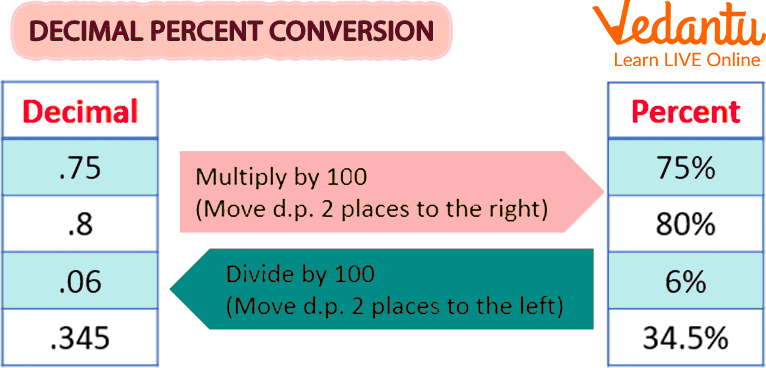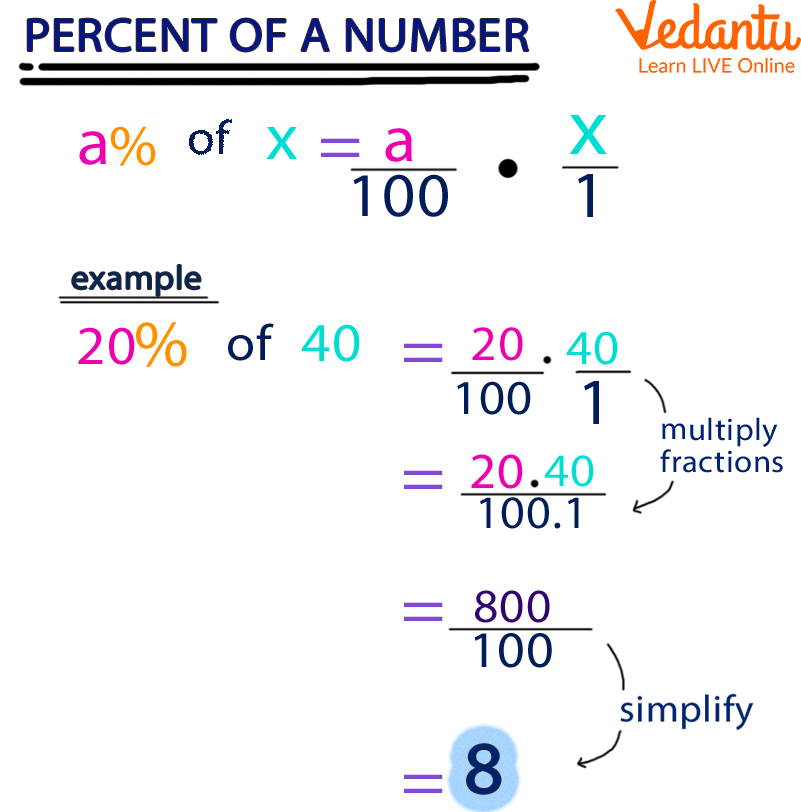




Step-by-Step Guide: Decimal to Percentage Conversion
A decimal number is one in which the whole number component and the fractional component are separated by a decimal point. The decimal point is the dot found in decimal numbers. The decimal point is followed by digits representing a number less than one.
Examples 1: 57.5 is a decimal number.
Here, 57 is a whole number part and 5 is the fractional part.
“.” is the decimal point.
Example 2: 78.9 is a decimal number
Here, 78 is a whole number part and 9 is the fractional part.
“.” is the decimal point.
In this article, it is explained how to convert decimal into percentages and how to convert a percentage to a number.
Types of Decimal Numbers
Decimal Numbers can be classified as:
Recurring Decimal Numbers
Example: 3.125125 (Finite), 3.121212... (Infinite)
Non-Recurring Decimal Numbers
Example: 3.2376 (Finite), 3.137654 (Infinite)
Example: $85.15=\frac{8515}{100}$
$32.5425 =\frac{325425}{10000}$
How to Convert Decimal into Percentage?
The method for converting a decimal into a percentage is as follows:
Step 1: Get the number's decimal format.
Step 2: In this step, multiply the decimal amount by 100 and add the percent sign (%)
Remember: The decimal point must move two places to the right when multiplying a decimal number by 100. (add zeros if necessary).

Decimal Percentage Conversion
Percentage
A figure or ratio stated as a fraction of 100 is called a percentage. The percent sign, " %", is frequently used to indicate it. A percentage is a number without dimensions and without a standard measurement.
Example percentages include:
20 % is similar to a $\dfrac{1}{5}$ fraction
25% is equal to $\dfrac{1}{4}$ of a fraction
50% is equivalent to a $\dfrac{1}{2}$ fraction
75% is equal to a $\dfrac{3}{4}$ fraction
Percentage Formula
To determine the percentage, we divide the data by the total value and then multiply the obtained value by 100.
Percentage Formula = $\dfrac{\text{Value}}{\text{Total Value}}\times100$
Example: $\dfrac{2}{5}\times 100% = 0.4 \times 100%=40 %$

Convert Percentage to a Number
How to Convert Percentage to Number?
To calculate the percentage of a number, we use the formula:
P % of Number = X, where X is the required percentage.
If we remove the symbol %, then the new formula will become;
$\dfrac{P}{100}\times Number=X$
From the above formula, it can be seen how to convert a percentage into a number.
Solved Examples
Example 1: Calculate 20% of 80.
Ans: We will calculate the value by the given formula,
$\dfrac{P}{100}\times Number=X$
Let 20% of 80 = X
$\dfrac{20}{100}\times 80=X$
$X=16$
Example 2: Calculate 15% of 200.
Ans: We will calculate the value by the given formula,
$\dfrac{P}{100}\times Number=X$
Let 15% of 200 = X
$\dfrac{15}{100}\times 200=X$
$X=30$
Practice Problems
Q1. Which of the following percentage is equivalent to 0.235?
23.5%
235.0%
2.35%
None of the above
Q2. Express the given decimals as percentages-
0.45
0.067
0.306
Summary
In the given article, the conversion of decimal and percentage is discussed. This article gives us the basic knowledge of decimal, types of decimal, and related practice problems. Later, percentage and conversion tricks are given.
FAQs on How to Convert Decimal to Percentage
1. What is the fundamental rule for converting a decimal to a percentage?
The simplest rule to convert any decimal to a percentage is to multiply the decimal number by 100 and then attach the percent symbol (%). This process is equivalent to shifting the decimal point two places to the right.
2. How do you convert a decimal like 0.68 into a percentage?
To convert the decimal 0.68 to a percentage, you follow a two-step method:
- Step 1: Multiply the decimal by 100. For example, 0.68 × 100 = 68.
- Step 2: Add the percent symbol (%) to the result. Therefore, 0.68 is equal to 68%.
3. What does it mean when converting a decimal like 1.45 results in a percentage greater than 100%?
Yes, a decimal greater than 1 can be converted into a percentage, which will always be greater than 100%. For example, converting 1.45 gives 145%. A percentage over 100% signifies a value that is more than the whole amount. This is common in contexts like profit margins or population growth where a quantity increases beyond its original size.
4. Why does the method of multiplying by 100 work for decimal-to-percentage conversions?
The word 'percent' literally means 'per hundred.' A decimal, like 0.75, represents a part of one whole. By multiplying it by 100, you are essentially scaling this value to find out how many parts it would represent if the whole were 100. So, 0.75 × 100 equals 75, which means 75 parts out of 100, or 75%.
5. What is the most common mistake students should avoid when converting decimals to percentages?
A very common error is forgetting to multiply by 100 and just adding the percent symbol to the decimal itself. For instance, incorrectly writing 0.35 as 0.35%. The correct method requires multiplying 0.35 by 100 to get the right answer, which is 35%. Always remember to shift the decimal two places to the right.
6. What is the importance of converting decimals to percentages in real-world scenarios?
This conversion is crucial for understanding information in everyday life. Key examples include:
- Finance: An interest rate of 0.07 on a loan is understood as a 7% interest rate.
- Shopping: A discount presented as 0.20 off the price is a 20% discount.
- Academics: If you score 40 out of 50 on a test, your score is 0.8, which converts to 80%.
7. How are decimals, percentages, and fractions related concepts?
Decimals, percentages, and fractions are three different ways to express the same partial value. They are inter-convertible and represent a number that is not a whole number. For example, 'three-quarters' can be written as:
- A fraction: 3/4
- A decimal: 0.75
- A percentage: 75%
Understanding these relationships is a fundamental skill in mathematics for comparing and calculating different forms of data.
8. What is the quickest way to mentally convert a decimal to a percentage?
The quickest mental trick is to simply move the decimal point two places to the right and add a percent sign. For example, for 0.125, you would move the decimal point past the 1 and the 2, placing it after the 2 to get 12.5. Then, just add the '%' symbol to get 12.5%. This shortcut directly achieves the result of multiplying by 100.























